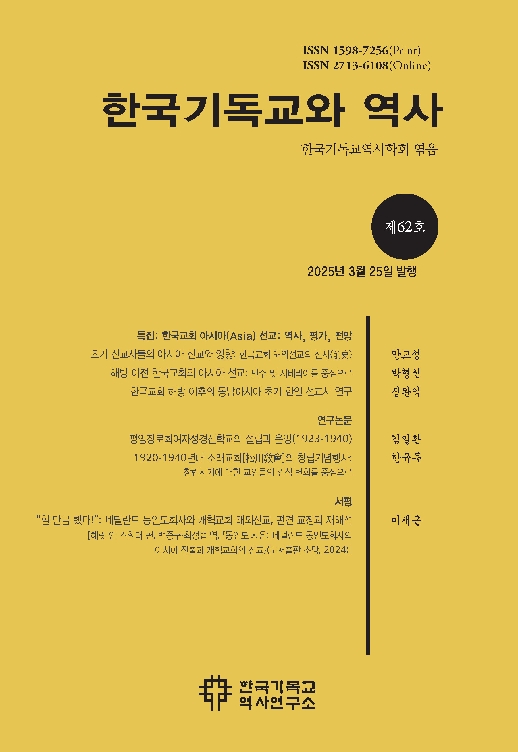이 글은 1945년 이전에 감리교회, 장로교회, 침례교회, 및 성결교회가 만주와 시베리아 지역에서 행했던 선교 활동을 재구성하고 선교의 과정에서 나타난 주제와 문제점을 확인함으로 오늘날의 선교를 위한 역사적 교훈을 제공함을 목적으로 한다. 주제와 문제점으로서는, 선교를 위한 정책결정과 파송, 이주민이 주도하는 전도 활동과 교회설립, 선교 활동과 선교지 조직관리, 선교구역 분할정책, 선교지역에서 기독교 전통 간의 경쟁과 불관용, 변화하는 정치·사회적 상황에서 신자들이 경험한 폭력과 신앙적 대응, 서구 선교부의 역할, 사회적 책임에 헌신한 기독교인, 등을 포함한다. 연구를 위한 사료로는 각 교파별 노회록, 연회록, 총회록, 선교부 연례보고서 등의 회의자료를 중심으로 하고 「기독신보」, 「감리회보」, 「활천」, The Korea Mission Field 등 정기간행물을 활용하였다. 이 연구는 기독교 선교, 특히 이주민 선교와 난민선교 등의 분야에서 새로운 통찰을 제공할 수 있다.
This study aims to reconstruct the missionary activities of the Methodist, Presbyterian, Baptist, and Holiness churches in Manchuria and Siberia before 1945. By identifying the key themes and issues that arose in the course of their missions, this paper seeks to provide historical lessons for Christian mission today. The themes and issues examined include: policy-making and the dispatch of missionaries; evangelistic activities and church planting led by migrants; the management of mission field organizations; the policy of dividing mission territories; competition and intolerance among different Christian traditions in the mission field; the violence experienced by believers amid changing political and social situations and their faith-based responses; the role of Western mission boards; and Christians who were dedicated to social responsibility. The primary sources for this research consist of official records from each denomination, such as the minutes of presbyteries, annual conferences, and general assemblies, as well as annual mission board reports. Periodicals such as the Gidok Sinbo (The Christian Messenger), Gamri Hoebo (The Methodist Bulletin), Hwalcheon (Living Water), and The Korea Mission Field were also utilized. This study can offer new insights into the field of Christian missions, particularly concerning missions to migrants and refugees.






